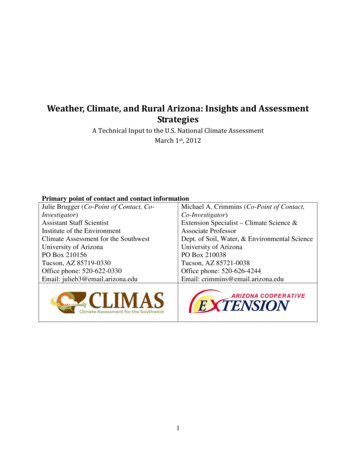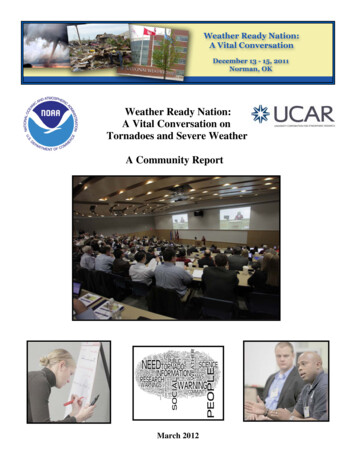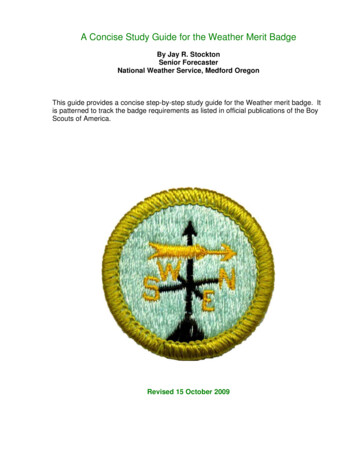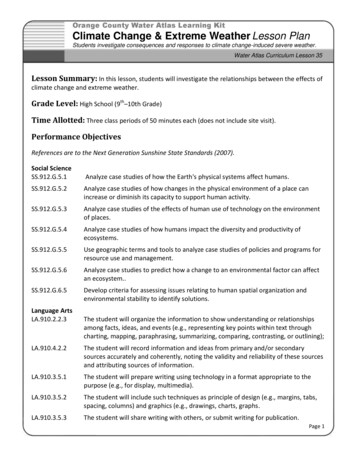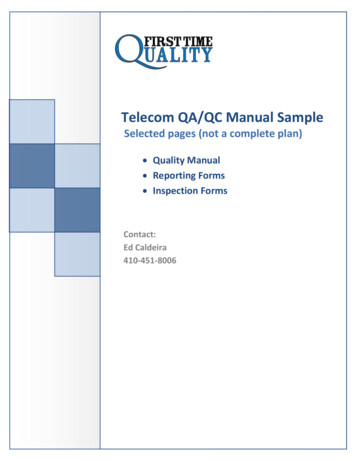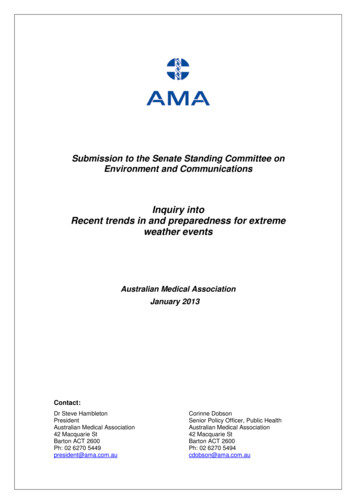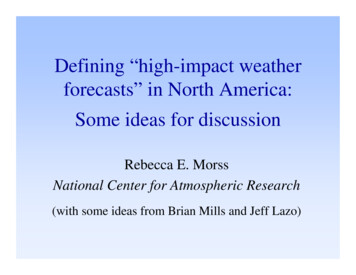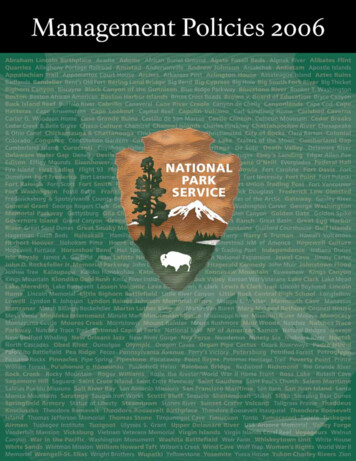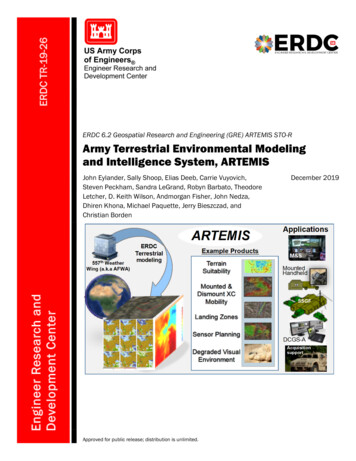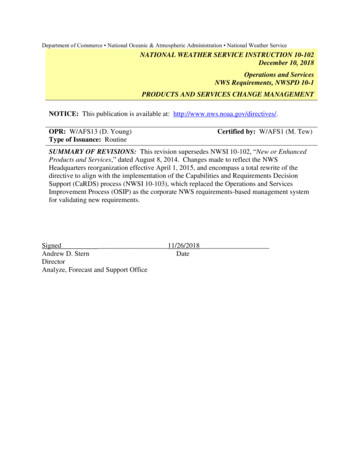
Transcription
Department of Commerce National Oceanic & Atmospheric Administration National Weather ServiceNATIONAL WEATHER SERVICE INSTRUCTION 10-102December 10, 2018Operations and ServicesNWS Requirements, NWSPD 10-1PRODUCTS AND SERVICES CHANGE MANAGEMENTNOTICE: This publication is available at: http://www.nws.noaa.gov/directives/.OPR: W/AFS13 (D. Young)Type of Issuance: RoutineCertified by: W/AFS1 (M. Tew)SUMMARY OF REVISIONS: This revision supersedes NWSI 10-102, “New or EnhancedProducts and Services,” dated August 8, 2014. Changes made to reflect the NWSHeadquarters reorganization effective April 1, 2015, and encompass a total rewrite of thedirective to align with the implementation of the Capabilities and Requirements DecisionSupport (CaRDS) process (NWSI 10-103), which replaced the Operations and ServicesImprovement Process (OSIP) as the corporate NWS requirements-based management systemfor validating new requirements.Signed11/26/2018Andrew D. SternDateDirectorAnalyze, Forecast and Support Office
NWSI 10-102 December 10, 2018Products and Services Change ManagementTable of ContentsPage1 Purpose. 32 Framework . 32.1 Applicability . 32.1.1 New Dissemination Services. 42.1.2 Web pages and Display Applications . 42.1.3 New or Enhanced Models to be Implemented by NCEP . 42.2 Consistency of Services . 52.3 Preliminary Steps . 52.3.1 Preliminary Development . 62.3.1.1 Local Development . 62.3.1.2 Regional/National Development . 62.3.2 External Feedback on Preliminary/Prototype Development . 6Tracking and Review Process . 73.1 Entry into the 10-102 Tracking/Review Process . 83.2 NWS-wide Reviews . 83.2.1 PSCM Team Review . 93.2.2 SPT/MST Review . 93.3 AFSO Review/Approval . 103.3.1 Approval Package Documents . 103.3.2 AFSO Review . 103.3.3 Approval/disposition . 104 Development . 105 Experimental Demonstration/Comment and Review . 115.1.1 Notification and Feedback . 115.1.2 Dissemination of Web-based Experimental Products/Services . 125.1.3 Duration. 125.1.4 Evaluation for Operational Implementation. 126 Extended/New Comment Period. 137 Discontinuing an Experimental Product/Service . 148 Operational Implementation of Products/Services . 148.1.1 Notification . 148.1.2 Directives Review/Official Product Designation . 149 National Catalog of New or Enhanced Products and Services Website . 1410 Provision for Emergencies . 153– Definitions . A-1– PSCM Team and SPT/MST Reviews. B-1– Approval Package Documents . C-1– AFSO Review and Approval. D-1– Product/Service Description Documents .E-1– Product/Service Evaluation and Decision Recommendation Document . F-1– Guidelines for Preparation of PDDs and SDDs . G-1– Examples of Product/Service Description Documents . H-12
NWSI 10-102 December 10, 20181PurposeThe purpose of this directive is to describe the procedures for implementing a new product orservice, or making a substantial change to an operational product or service (enhanced product orservice) in the National Oceanic and Atmospheric Administration’s (NOAA’s) National WeatherService (NWS). Procedures in this directive are consistent with NWS Policy Directive(NWSPD) 10-1, NWS Requirements, Operations and Services Improvements, as well asNWSPD 1-10, Managing the Provision of Environmental Information and its supportinginstructions. The specific procedures for sending out notifications when needed as part of thisprocess are addressed in NWS Instruction (NWSI) 10-1805, National Service Change andTechnical Implementation Notices.Objectives of the procedures in this directive are to ensure that:a. Innovative field efforts yield nationally comparable, mission-relevant products andservices;b. New or enhanced products/services are not a duplication of existing products/services;c. NWS resources are directed towards the projects that will have the greatest benefit forNWS users and partners;d. New or enhanced products/services are in alignment with Department of Commerce(DOC), NOAA, and NWS priority goals and policy;e. An orderly process for implementing and documenting new or enhancedproducts/services is followed;f. Proposed new or enhanced products/services are subject to internal NWS-wide review(including NWS Policy review and General Counsel review as appropriate);g. All proposed new or enhanced products/services are subject to external comment andreview to solicit feedback from our partners and the public;h. Procedures are in place to evaluate feedback from external comment and review and todecide if the proposed new or enhanced product/service should be made operational(official), improved and reissued for additional comments or discontinued;i. All new/enhanced NWS products and services are introduced to their audiences in amanner that is most likely to benefit NWS partners and users;j. All new models to be implemented by National Centers for Environmental Prediction(NCEP) are subject to Mission Delivery Council (MDC) review; andk. All new/enhanced NWS product and services are socialized with the Weather andClimate Enterprise per NOAA Partnership policy.2FrameworkThis section describes the applicability of the procedures in this directive, exemptions from theprocedures in this directive, and principles for understanding the procedures.2.1ApplicabilityThe procedures in this directive apply to implementing new products/services and makingsubstantial changes (enhancements) to existing operational products/services in the NWS. Theprocedures apply to all NWS products/services that are provided to the public regardless of3
NWSI 10-102 December 10, 2018output type (e.g., text, graphical, digital, Geographic Information Systems (GIS)) or method ofdelivery (e.g., Internet, email, social media). For a complete definition of what constitutes a“substantial change” to an NWS product or service, see NWSPD 1-10, Attachment 2.2.1.1 New Dissemination ServicesNew dissemination systems/services (including social media tools) that are used to provideenvironmental information (see NWSPD 1-10 for definition of environmental information) mustbe approved through the procedures described within this directive (hereafter referred to as “10102 process”), or otherwise undergo public comment and review per NWSPD 1-10.1 Once anew dissemination system/service is operational, any existing operational NWS product/datasetcan be provided via that system/service.Note: New/enhanced products/datasets must first be approved through the 10-102 process priorto posting via an operational dissemination system/service. Approved prototypes/experimentalproducts may be made available via an operational dissemination system/service to solicitfeedback, provided the prototype/experimental product is clearly labeled as such using thedisclaimer provided in section 2.4.2.2.1.2 Web pages and Display ApplicationsExisting operational products/datasets can be displayed on a separate web page or using anapproved operational display application for ease of access/use, without approval through the 10102 process. However, if the existing operational product/dataset is displayed using a newcapability/feature, then the web page or display application needs to go through the 10-102process for approval of the new capability/feature.2.1.3 New or Enhanced Models to be Implemented by NCEPNew models (i.e., those that currently do not exist within the operational production suite) to beimplemented by the National Centers for Environmental Prediction (NCEP), including thosedeveloped within NWS and those developed by other NOAA line offices, that follow the formalNCEP procedures for model implementations/upgrades will be entered into CaRDS.NWS-developed models should be entered into CaRDS prior to development, while otherNOAA line office models should be entered into CaRDS prior to NWS committing resources tooperational implementation. Once entered into CaRDS (Tier1), the request is forwarded directlyto Tier 3 for an operations and policy review before proceeding to the MDC (Tier 4) for reviewand approval. This MDC review is necessary to integrate NWS weather, water and climaterequirements and ensure a holistic view of requirements and priorities. When approved by theMDC, these models will be entered into the National Catalog of New or Enhanced Products andServices for 10-102 tracking. It is not necessary for these models and related output to proceedthrough the 10-102 Service Program Team (SPT)/Mission Support Team (MST) review process(Tier 2); however, these products are subject to public comment and review as identified inNWSPD 1-10. Final approval for implementation is managed through the NCEP modeldevelopment/implementation process.1Although changes to dissemination systems/services managed by the Office of Dissemination use a differentapproval process (refer to NDS 10-17), they must still go through public comment/review as identified in NWSPD1-10 to fulfill NOAA Partnership Policy requirements.4
NWSI 10-102 December 10, 2018Updates/enhancements to existing models (i.e., extension of an existing operational modelingsystem such as adding new grids) do not require CaRDS/MDC review. However, these changeswill be entered into the 10-102 process through the CaRDS interface and the National Catalog ofNew or Enhanced Products and Services for tracking. These changes are also subject tocomment/review as identified in NWSPD 1-10 and will follow the formal NCEP procedures formodel implementations/ upgrades.2.2Consistency of ServicesNWS products and services should be offered consistently across the NWS and seamlesslyacross regional boundaries. Products/services approved for national implementation should beavailable for issuance by all equivalent NWS offices (e.g., all Weather Forecast Offices (WFOs),all coastal WFOs, all Center Weather Service Units (CWSUs) or all River Forecast Centers(RFCs)). Requirements for issuance of a particular product will be specified in the ProductDescription Document (PDD)/Service Description Document (SDD) or directive documentingthat product/service (see Appendix E). Local management may determine appropriate thresholdsfor issuance of nationally implemented products/services if not otherwise defined in an NWSdirective. Variations in products/services (e.g., Wind Chill, Snow, Extreme Heat hazards) areacceptable in the following cases: Products and services in a particular program area (e.g., marine and coastal weatherprogram) may not be required by a particular NWS office due to geographicaldifferences; A unique user need is identified at one or a subset of NWS offices; or Thresholds for issuance of a particular product/service may vary from office to office orregion to region and may be determined by local/regional management. For example, if a“High-Impact Weather Graphic” were approved for national implementation, the graphicwould only be provided when conditions are considered “high impact,” and what isconsidered to be high impact may vary across the country.To support the principles of “consistency of services,” the following should be considered beforedeciding to make a change/enhancement to an existing national operational product/service at thelocal/regional level.a. A proposed non-substantial change to an existing national product/service should beimplemented at the national level or not at all.b. A proposed substantial change to an existing national product/service will be evaluatedfor implementation at the national level or for local/regional implementation, if theproposed change satisfies a unique local/regional need.2.3Preliminary StepsA new/enhanced product/service begins as a concept/idea based on user needs/proposedrequirements.Before any development takes place, the following steps should be taken by the originator:5
NWSI 10-102 December 10, 2018a. Ensure the proposed product/service/enhancement is consistent with the NWS Missionand Policy and the NOAA Partnership Policy (NWSPD 1-10, sections 2–4).b. Review the National Catalog of New or Enhanced Products/Services) and other availabledatabases of ongoing development efforts (e.g., the Capabilities and RequirementsDecision Support (CaRDS) process – NOAA login required for this site; NWSI 10-103,Capabilities and Requirements Decision Support Process) to ensure efforts are notalready underway, or completed, on a similar product/service.c. Ensure that the proposed product/service/enhancement is supported by a validated NWSrequirement. New requirements must first be validated through the CaRDS process.d. Determine the appropriate geographic area/scope (local, regional, or national).A proposed product/service/enhancement that requires significant resources (e.g., database,web development, contractors) must first be submitted into the CaRDS process.2.3.1 Preliminary DevelopmentPreliminary investigational development may be necessary to validate that the proposedproduct/service/enhancement will meet user needs as intended.2.3.1.1 Local DevelopmentIf local development is planned, obtain approval from local management prior to beginning thedevelopment. Such development should be limited to preliminary/prototype development, whichwill be used to validate that the proposed product/service/enhancement will meet user needs.Significant resources should not be expended because implementation of preliminary/prototypedevelopment is not guaranteed. Note: If significant resources are required to develop a localprototype, then other methods (e.g., mock-up, graphical representation) may be used instead todemonstrate the proposed solution.2.3.1.2 Regional/National DevelopmentInitial development at the regional/national level (e.g., NCO, MDL, OWP) resulting in a new orenhanced product/service should be limited to preliminary/prototype development. Significantresources should not be used as implementation of the preliminary/prototype development is notguaranteed. Note: If significant resources are required to develop a prototype, then othermethods (e.g., mock-up, graphical representation) may be used instead to demonstrate theproposed solution.2.3.2 External Feedback on Preliminary/Prototype DevelopmentExternal feedback may be solicited based on a prototype or mock-up to validate usefulness andability to communicate intent. A prototype will be clearly labeled as:“Prototype/Under Development: Prototype is for demonstration/test purposes only—Notto be relied on for operational decision making. This prototype is not supported 24/7 andmay be discontinued at any time without advance notice.” The prototype will be providedexternally for no longer than 90 days.Seeking public comment/review on preliminary/prototype development may be preferable towaiting until substantial development has been completed, especially where significant and6
NWSI 10-102 December 10, 2018potentially opposing input is expected. In these cases, external feedback may be obtained on theprototype by first entering the prototype/proposed solution into the 10-102 Tracking/ReviewProcess for NWS-wide review, decision, and approval. Requests that require substantialresources will be submitted into the CaRDS process.3Tracking and Review ProcessThis section describes the tracking and review process to implement a new product/service or tomake a substantial change to an existing NWS operational product/service. The process, whichincludes three basic stages (below), provides the procedures to track and review the newproduct/service from development through implementation. Stage 1 DevelopmentStage 2 Experimental comment and reviewStage 3 Operational implementationFigure 1 (below) depicts the steps for the process to develop, evaluate, and implementnew/enhanced products and services.Figure 1. NWS 10-102 Process Diagram.7
NWSI 10-102 December 10, 20183.1Entry into the 10-102 Tracking/Review ProcessA new entry or proposed new/enhanced product/service that is not supported by a validatedrequirement must first be entered into the CaRDS process as a New Mission Need orRequirement Request for validation of the requirement. A new entry or proposed new/enhancedproduct/service (hereafter referred to as new entry or proposal) supported by a validatedrequirement will be submitted to Product and Services Change Management (PSCM) for entryinto the 10-102 Tracking/Review process.a. The originator will download the new entry form (see Appendix G for an example) andthe template for the preliminary/draft PDD/SDD (if applicable) from the CaRDSDashboard. The completed entry form and preliminary/draft PDD will be forwarded viaemail to local management for approval. If approved, the approving manager willforward the entry form and preliminary/draft PDD to the designated submitter (link to listof designated submitters) for entry into the 10-102 process.b. The designated submitter will review the new entry to ensure appropriateness andconcurrence with policy and will make the request “visible” to the Financial ManagementCenter (FMC) Director (in the manner specified by the FMC Director). If necessary, thesubmitter can engage the FMC Director or others, in the manner specified by the FMCDirector, to address issues. If approved, the designated submitter will submit the newentry request via the CaRDS Dashboard. If not approved, the designated submitter willinform the originator and provide rationale.c. The CaRDS Program Manager and the PSCM Lead will review the new entry to ensurethe proposal is supported by a validated NWS requirement and identify resource needs: 3.2If the proposal is supported by a validated NWS requirement, the request willcontinue through the 10-102 process.If the proposal is not supported by a validated NWS requirement, it will proceedthrough the CaRDS process for validation as a new NWS requirement. When asolution for the proposed product/service has been identified, the solution willcomplete the 10-102 process, as applicable.If significant resources are requested, the proposal will be entered into the CaRDsprocess.NWS-wide ReviewsUnder the authority of the Director of the Analyze, Forecast and Support (AFS) Office, thePSCM Team, SPTs, and MSTs (formally Corporate Project Teams [CPT]) conduct preliminaryand cross-NWS reviews for proposed new/enhanced products/services. Products and Services Change Management Team – The Team conducts preliminaryreviews for all proposed new/enhanced products/services to ensure compliance withpolicy, as described in this document. The Team consists of three members or theirdesignee(s): the Program Manager for PCSM within the Analyze, Forecast and SupportOffice (AFSO), Digital and Graphical Information Services Branch (AFS13); the8
NWSI 10-102 December 10, 2018 Division Chief for the Analysis and Mission Support Division (AFS1) or designee; and apolicy representative from the Office of the Chief Operating Officer (OCOO).Service Program Team (SPT) – The appropriate SPT conducts NWS-wide reviews forall proposed new/enhanced products/services. Each of the 11 National Service Programs(NSP) within the AFSO Forecast Services Division (AFS2) has a corresponding SPT:Aviation Services, Climate, Fire Weather, Marine Weather, Public Weather, SevereWeather, Space Weather, Tropical Weather, Tsunami, Water Resources, and WinterWeather. Each SPT includes voting members from the NWS Headquarters (NWS HQ),each region, and NCEP and the Office of Water Prediction (OWP), as applicable. Nonvoting members and advisors include representatives from the NWS EmployeesOrganization (NWSEO), MST, Service Delivery Portfolios (SDPs) and otherstakeholders as identified by the PSCM Team and SPT.Mission Support Team (MST) – The appropriate MSTs provide input to SPT reviewsfor proposed new/enhanced products/services that involve/impact their supportingprograms or initiatives to ensure alignment with Agency priorities and strategicinitiatives. There are currently six MSTs within the AFS1: Analysis & Nowcast (AN)program, Warning Coordination Meteorologist (WCM) program, Impact-Based DecisionSupport Services (IDSS) Initiative, Digital and Graphical Information Support (DGIS)program, IDSS Management System (IMS) Initiative, and Collaborative Forecast Process(CFP) Initiative. Each MST includes voting members from the regions, NCEP and theOWP, as applicable. Non-voting members and advisors include representatives fromNWSEO, other MSTs, SDPs and other stakeholders, as identified by the PSCM Teamand SPT.PSCM Team/SPT/MST reviews will be conducted prior to each stage in the 10-102 process. SeeAppendix B for details.3.2.1 PSCM Team ReviewThe PSCM Team Lead will initiate a review of the proposed new/enhanced product/service. TheTeam members will provide their input to the Team Lead within three business days of therequest.3.2.2 SPT/MST ReviewNo later than three business days after the completion of the PSCM Team review, the PSCMTeam Lead will email the members of the appropriate SPT(s)/MST(s) to initiate the SPT/MSTreview. The PSCM Team recommendation, along with specific issues to address, will beincluded in the email. The email will be forwarded to the Regional Meteorological ServicesDivision (MSD) Chiefs, the Regional Scientific Services (SSD) Division Chiefs, the RegionalHydrological Services Division (HSD) Chiefs, and NCEP and OWP front offices for situationalawareness.Most reviews can be conducted virtually; more complex proposals may require a formal meeting.The SPT/MST Lead(s) will complete the Experimental Product Decision Information Document(EPDI) and provide a recommendation (for the designated approving official) to the PSCMTeam Lead no later than 15 business days of receipt of the request for review. If more time isneeded to review, then the SPT/MST Lead(s) will notify the PSCM Team Lead via email.9
NWSI 10-102 December 10, 20183.3AFSO Review/ApprovalAFSO reviews, with final approval by the AFSO Director, will be conducted prior to each stagein the 10-102 process. See Appendix D for details.3.3.1 Approval Package DocumentsThe PSCM Program Manager will work with the SPT/MST Lead(s) to complete an approvalpackage for review by the designated approving official. See Appendix C for specific details.The approval package should be completed and circulated for AFSO review no later than fivebusiness days after SPT/MST approval.3.3.2 AFSO ReviewThe PSCM Program Manager will circulate the approval package via email for review andclearance through the appropriate AFS1 and AFS2 Branch and Division Chiefs (or designees)and OCOO (for policy review and recommendation) prior to forwarding to the approvingofficial’s Executive Officer for signature. AFSO review will generally be completed within tenbusiness days. The PSCM Lead will review and forward the documents to the approving officialwithin two business days of completion of the review.3.3.3 Approval/dispositionAll proposed new/enhanced products/services will be approved by the designated approvingofficial prior to each stage in the 10-102 process, with final review/approval by the AFSODirector. If the SPT/MST verifies that the proposed product/service addresses a uniquelocal/regional user need, the appropriate Regional Director (RD) is the designatedapproving official. If more than one region is involved, RD approval from those regionswill be required. Final review/approval by the AFSO Director is required.If the SPT/MST verifies that the proposed product/service is suitable for nationalimplementation, the AFSO Director is the designated approving official.The approving official will review the approval package, provide a decision and return theapproval package (with the signed EPDI and approval memo) to the PSCM Lead within 15business days of receipt of the package. See Appendix D for details.4DevelopmentAfter the approving official has signed the approval memo, work can begin/continue ondevelopment of the proposed new/enhanced product/service and any required softwareapplications. Accepted practices and applicable policies (e.g., change management procedures)will be followed. During development, the SPT/MST Lead will coordinate with the developers,and the Office of Planning and Programming for Service Delivery (OPPSD) portfolios (whichare responsible for identifying and managing development projects, facilitating coordinationamong developers, tracking progress and providing reports, and maintaining developmentmanagement web pages) to ensure that the proposed new/enhanced product/service meets theuser need as intended and that the operational requirements are fully met. During development,10
NWSI 10-102 December 10, 2018prototypes may be made available to the public to solicit comments, upon SPT/MSTconcurrence. A draft public information statement (PNS) may be used to solicit comments. Thefollowing disclaimer must be prominently displayed on the prototype:“Prototype/Under Development: Prototype is for demonstration/test purposes only—Not tobe relied on for operational decision making. This prototype is not supported 24/7 andmay be discontinued at any time without advance notice.”Prototypes may be provided externally for no longer than 90 days. PSCM approval must beobtained for periods longer than 90 days.When development has been completed (whether completed within a service program fieldoffice or OPPSD portfolio) and the proposed new/enhanced product/service is deemed ready forexperimental comment and review, the SPT/MST Lead(s) will notify the PSCM Lead via email.5Experimental Demonstration/Comment and ReviewOnce the proposed new/enhanced product/service has been approved as an experimentalproduct/service, the responsible office will begin distributing the experimental product/service tothe public with the primary purpose of receiving partner/user feedback. Procedures to use inobtaining feedback and the information needed to request a survey is provided in Section 5.1.1.The product’s labels will clearly identify it as experimental (e.g., Experimental PrecipitationRunoff Rate). If the product/service is available via the internet, the Uniform Resource Locator(URL) of the page will be included in the PDD/SDD. Links to the PDD/SDD and the surveywill be provided on the product web page.5.1.1 Notification and FeedbackA national PNS will be issued before distribution of any experimental product/service for thepurpose of soliciting feedback. The PNS will include a brief description of the experimentalproduct/service, methods of dissemination (including how to receive the product), links to thePDD/SDD and survey, dates of comment period, and a point of contact. Notification of anextension of comment period will be provided to partners/users by issuing a PNS throughcoordination with the NWS headquarters (HQ) and the responsible office; advance notification isnot required. If applicable, notification will also occur on the website containing theproduct/service.Feedback wi
Department of Commerce National Oceanic & Atmospheric Administration National Weather Service NATIONAL WEATHER SERVICE INSTRUCTION 10-102 December 10, 2018 . (e.g., Wind Chill, Snow, Extreme Heat hazards) are . Determine the appropriate geographic area/s
